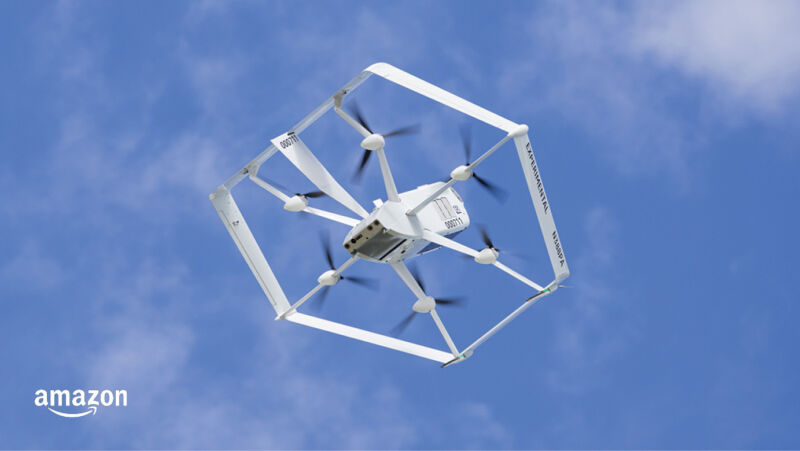
12-31 #Happy2023 : Qualcomm is likely to cut prices for its mid-range and entry-level Snapdragon; Qualcomm is making select head count reductions in certain functions; TSMC’s leading customers began to revise their orders to the company; etc.

The remaining buildings of OPPO Global Computing Power Center completed the complete acceptance and will soon be fully operational. The total investment is CNY4.5B, covering an area of 387 acres, which will be used to build chip research and development centers, chip experiment and testing centers, semiconductor equipment research centers, 5G terminal research and development centers, artificial intelligence research and development centers, etc. According to the investment agreement, the construction period of this project is 36 months, and the construction must be started by Jan 2024 at the latest, completed and accepted by Jan 2027, and put into production by Jan 2028. After being put into production in the future, the annual R&D investment will exceed CNY800M. (My Drivers, Sina, EET-China, Techgoing)
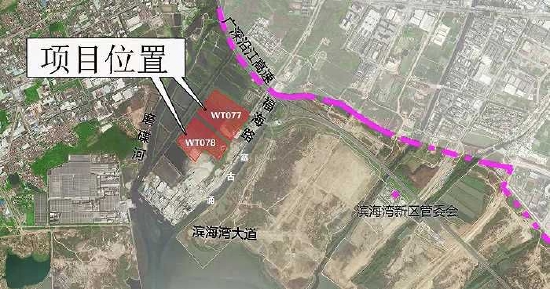
Ever since Qualcomm mentioned its Snapdragon chips would be used in more Galaxy devices starting in 2023, multiple reports have claimed that the Exynos 2300 is dead and that Samsung will exclusively use the Snapdragon 8 Gen 2 in the Galaxy S23 series. The 4nm Exynos 2300 chipset reportedly still exists, and it will power the Galaxy S22 FE and the Galaxy Tab S8 FE. (My Drivers, SamMobile, Twitter)
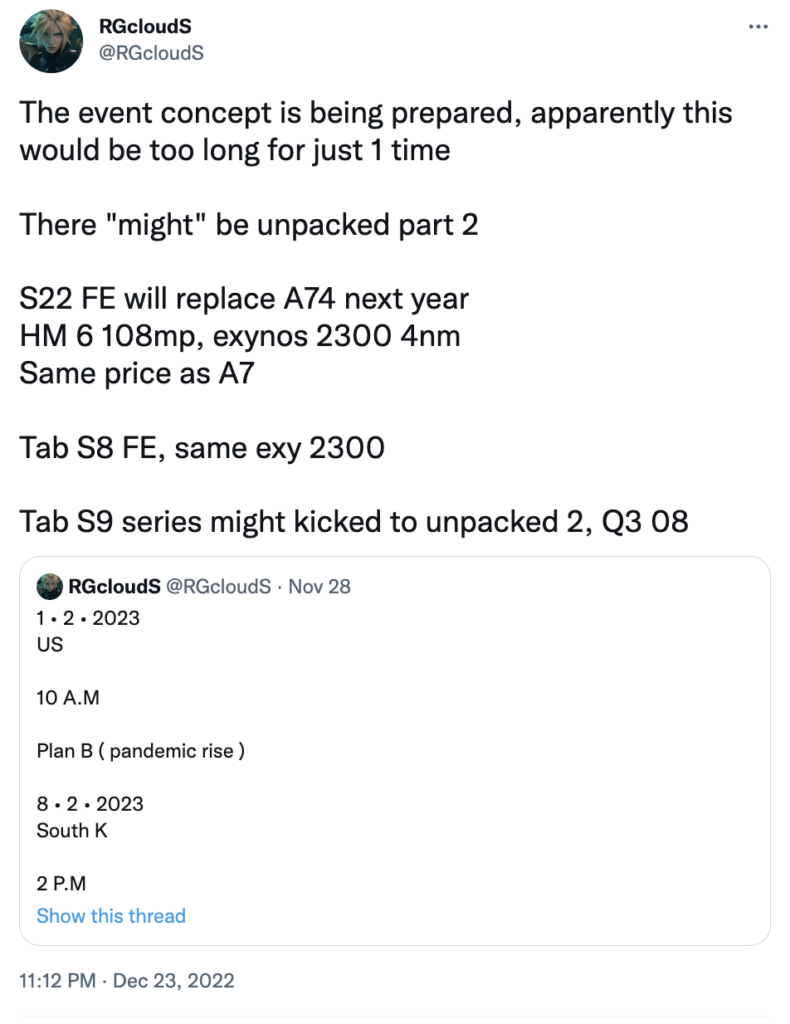
Qualcomm is likely to cut prices for its mid-range and entry-level Snapdragon mobile phone processors, including the 400 and 600 series, in 2023, according to Digitimes. The short-term purpose of this price cut is most likely to reduce inventory, but industry insiders worry that this may be the beginning of a price war for mid-range and entry-level mobile phone SoCs. Whether Qualcomm’s move will trigger a price war is unclear. Regardless, slowing demand in the mid-range and entry-level handset market and general price sensitivity increase the likelihood that handset brands will push Qualcomm and MediaTek to cut prices in the future. (Laoyaoba, Digitimes, Digitimes, DoNews, TechWeb)
Qualcomm’s CFO Akash Palkhiwala has revealed that the company is working to reduce operating costs and double down on new areas, including its automotive and Internet of Things business. Additionally, they are making select head count reductions in certain functions. The third thing is that they are preparing contingency plans.(Laoyaoba, WSJ, UDN)

The oversupply marks a sharp turnaround from a global shortage during 2 years of supercharged demand. Consumer appetite for electronics has weakened against a backdrop of rising interest rates, a falling stock market and recession fears. Chip inventories are swelling, mirroring what is happening in the wider economy where retailers are stuck with goods on their shelves and producers of a range of products in high demand early in the pandemic now face a glut. Chip executives have said they expect the situation to gradually improve in 2023, though there is still uncertainty about when an industry known for its sharp boom-and-bust cycles is poised for its next upturn. Despite the near-term glut, chip executives are preparing for a long-term rise in demand for chips that will require them to build more factories. Industry executives expect chip sales to roughly double by 2030, surpassing USD1T globally. (WSJ, article, Laoyaoba)
The A17 Bionic chip for Apple’s high-end models of the iPhone 15 lineup in 2023 could be 35% more efficient compared to current iPhone processors thanks to the use of newer 3nm chip process technology. Apple is expected to adopt the smaller 3nm process technology for the 2023 iPhone chip, destined to be the A17 Bionic. The current A16 Bionic chip uses TSMC’s 4nm process, which offers improved efficiency and performance compared to the A15 Bionic chip based on the 5nm process from the year prior. (Phone Arena, Bloomberg, 9to5Mac, Sina)
TSMC’s leading customers began to revise their orders to the company, affecting the foundry’s results starting from 4Q22, according to Digitimes. Virtually all TSMC clients will experience a downturn and have to cut orders, so TSMC’s utilization will decline significantly in 1Q23. For example, the utilization rate of TSMC’s N7-capable lines (7nm, 6nm-class technologies) will decline to around 50% in early 2023. Furthermore, even TSMC’s N5 / N4-capable lines will be underutilized, though this may not come as a surprise since these are used to make leading-edge products, like Apple’s smartphone SoCs, and demand for advanced handsets is usually down in the first half of the year. More alarming is that even N28-capable fabs — which have been fully loaded since the beginning of the chip deficit in early 2021 — will be underutilized. TSMC is reportedly willing to accept compensation (as it will hold wafers with chips from AMD, Intel, Nvidia, etc., before they are ready to buy them) and even renegotiate deals on long-term supply contracts (i.e., increase the number of wafers that a company is committed to buying in the future) in exchange. Such measures will not make TSMC’s life any easier 4Q22 or 2Q23, though. (Neowin, Tom’s Hardware, Digitimes)
The global cellular baseband processor market grew 19% to USD8.7B in 2Q22, according to Strategy Analytics. Qualcomm, MediaTek, Samsung LSI, Unisoc and Intel captured the top-five revenue share rankings in the baseband market in 2Q22. Qualcomm led the baseband market with a 59% revenue share, followed by MediaTek with 29% and Samsung LSI with 6%. 5G baseband revenues grew 40% YoY, while shipments grew 16%. In addition, the increased mix of higher-priced premium and high-tier 5G chips boosted ASPs (average selling price). (Strategy Analytics)
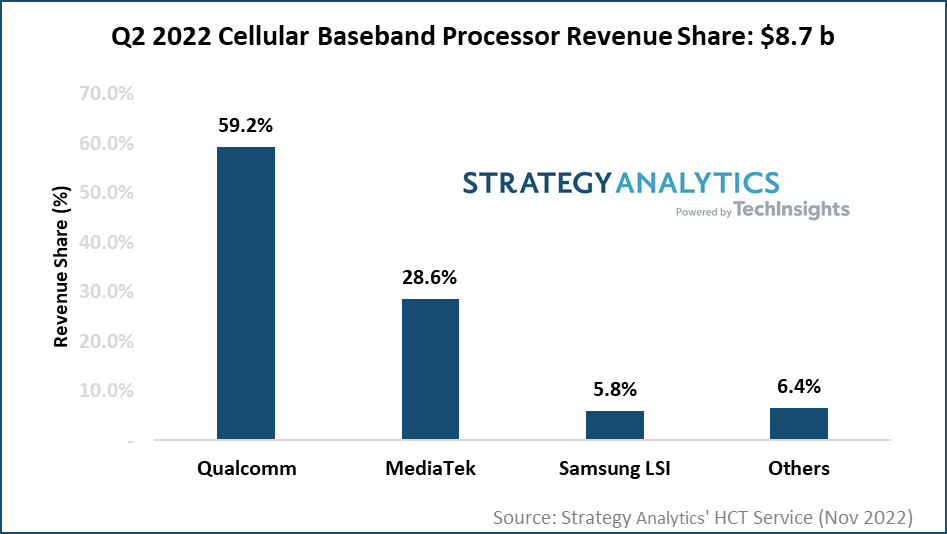

LG Electronics may launch a transparent OLED TV in 2024 at the earliest. LG Display (LGD) pitched the idea to the electronics maker earlier 2022; but such a model is not slated to launch in 2023. This is likely due to the demand for consumer electronics such as TVs dropping from the global economic downturn. Early 2022, LG Display suggested the idea to launch a 55” transparent OLED TV to LG Electronics’ Home Entertainment Company, its TV division. For a launch to happen in 2023, LG Electronics would have gone into development sometime during 2H22 but there were no such movements. A transparent OLED TV will involve LG Electronics covering the transparent OLED panel with reinforced glass. (The Elec)

TF Securities analyst Ming-Chi Kuo has stated that Apple’s rumored foldable iPad will have a “markedly higher price” than the iPad mini. Kuo adds that there is a new iPad mini in development, one that will bring a faster chipset. The 2021 model launched with the then current Apple A15 Bionic. The new mini is expected to arrive in late 2023 or 1H24 and by that time the A16 and A17 chipsets will be available. (GSM Arena, Twitter, GizChina)
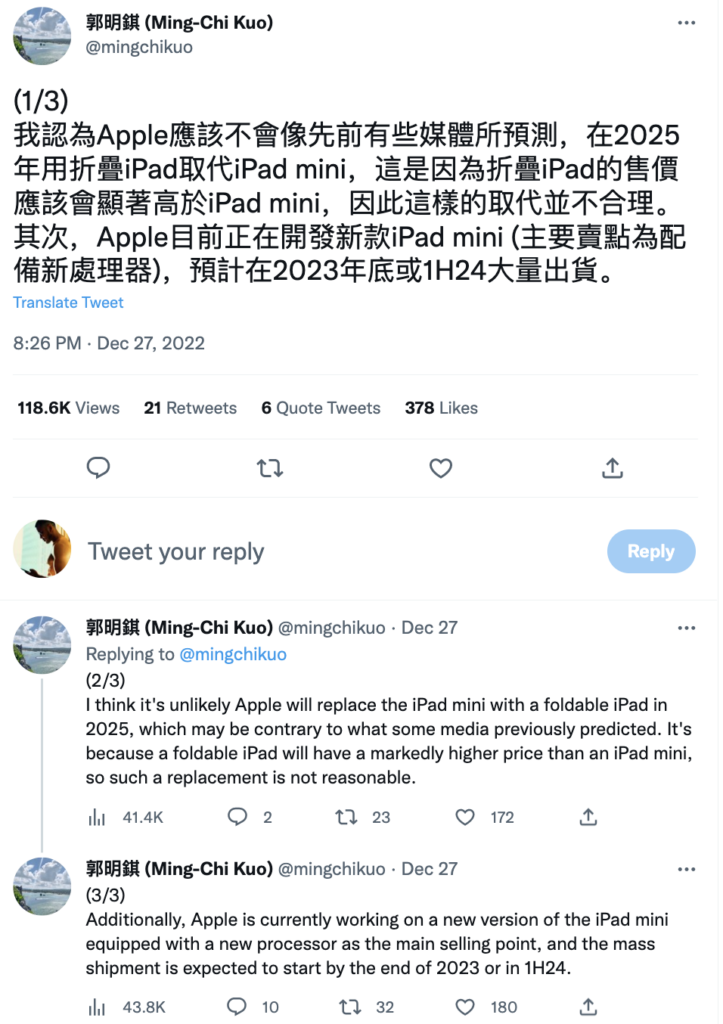
According to Digitimes, Epistar, which has been providing mini-LED displays to Apple for some time, has revealed that demand for mini-LED displays for use in consumer electronic devices is decreasing and that it expects demand for mini-LED displays for use in dashboards and displays for vehicles to spike in 2023. Apple is expected to announce the first iPad Pro with an OLED display in 2024, which has sparked mini-LED suppliers to eye other applications for its displays. (MacRumors, Digitimes)
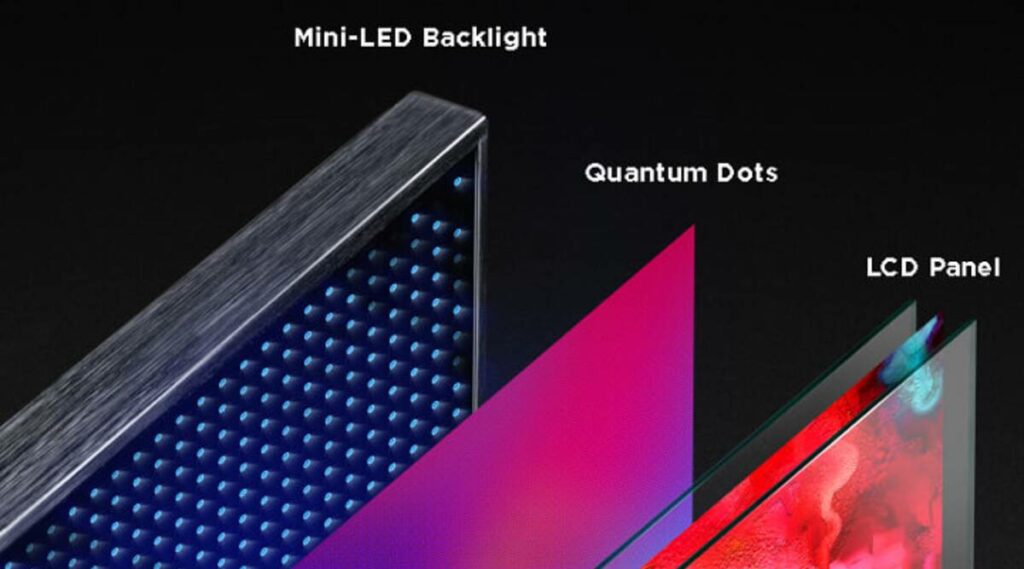
Samsung Display has been using an additional inkjet printing process in the production of OLED displays for Apple 14 series in order to protect them from moisture and oxygen. This process involved the use of inkjet equipment after the thin film encapsulation (TFE) process, which is normally used to protect OLED screens from moisture and oxygen. The additional inkjet equipment was used to create a separation between the hole in the display and the rest of the OLED panel, as well as to flatten areas with uneven heights. Prior to the iPhone 14 Pro, Samsung used to use the OLED inkjet printing deposition method during the TFE (Thin Film Encapsulation) process for the iPhone 13, iPhone 14, and iPhone 14 Plus. However, for the iPhone 14 Pro lineup, Samsung used additional inkjet equipment for TPE and the touch layer to enhance the display’s durability and life span. SEMES, a subsidiary of Samsung Electronics, manufactured the equipment that Samsung used to produce Apple’s display. LG Display, which also produced displays for the iPhone 14 Pro Max, also applied the same method.(Gizmo China, The Elec, SamMobile)

TrendForce projects that shipments of monitor panels will total just around 158M pieces for 2022, showing a YoY decline of 8.8%. According to TrendForce’s research on the market for display panels, monitor panels experienced a large downward shipment correction later than did TV and NB panels. For TV panels, the correction phase began in 3Q21. Turning to NB panels, a steep decline in shipments occurred in 2Q22. As for monitor panels, their shipments had not fallen significantly until 3Q22. With the correction taking place at a later time, the eventual rebound will also occur at a more distant time in the future. Since monitor brands are still holding an excessively high level of panel inventory at this moment, shipments of monitor panels are forecasted to drop again by 5.3% QoQ for 1Q23. (Laoyaoba, TrendForce, TrendForce)
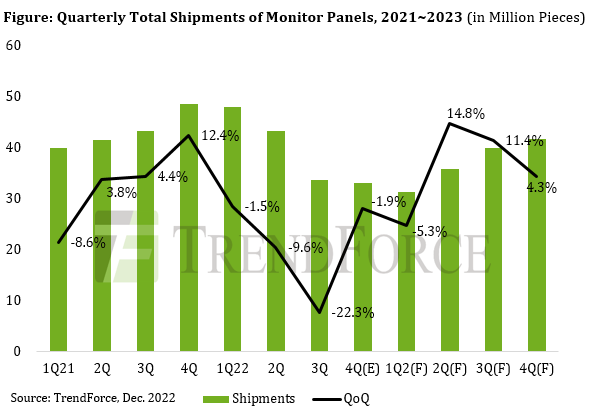

LG Innotek has revealed a new smartphone camera module that boasts a true optical telephoto zoom lens. The company states that this new telephoto module is capable of achieving a 4x to 9x optical zoom. LG Innotek says this could reduce the size of the dreaded camera bump that is customarily present on smartphones with a big and complex camera array. LG Innotek also says this new module can help with battery efficiency. According to LG Innotek, the module also has a built-in optical image stabilizer for cutting down on blur. LG Innotek has partnered with Qualcomm to implement this module as part of the new Snapdragon 8 Gen 2 mobile platform. The company says it will “enhance the image tuning custom for the optics, which includes Auto-Focus, Auto-Exposure, Auto-White Balance, lens shading correction and much more”. (Android Central, Android Headlines, LG Innotek)
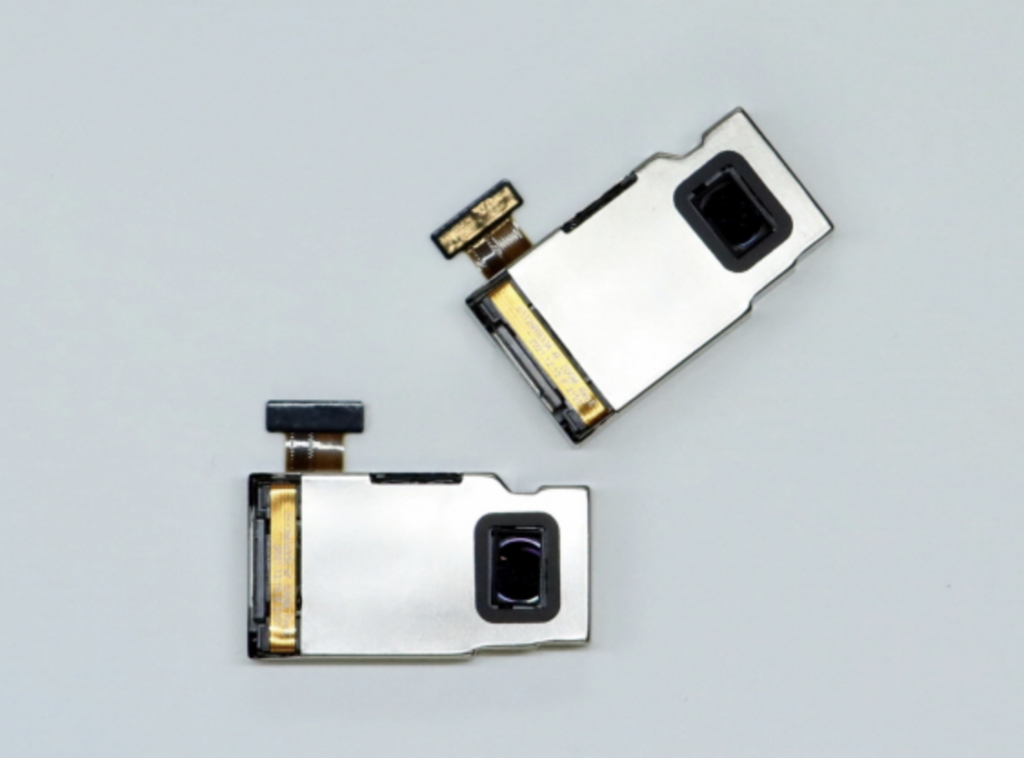
Tecno has confirmed it is having talks with established lens makers for the development of future products. Tecno mentioned no names. Hasselblad, Leica and Zeiss are already partnering with smartphone makers so we can rule those out. (GSM Arena)
Samsung is working on making the Camera Assistant app available for more devices. The app allows users to customize the settings of the camera to a level far beyond what is available using the controls on the stock camera app. The app gives users the option to enable or disable HDR, soft photo texture (to give photos softer details for a dream-like quality), and the automatic lens switcher which allows the phone to pick the best lens to use based on the zoom, lighting, and the distance to the subject. The app also allows users to shoot videos even while in photo mode by holding down the shutter button. The app will also turn off the camera automatically if it is not used within two minutes, and users can speed up the camera’s shutter. (Phone Arena, SamMobile, Samsung Communiity)
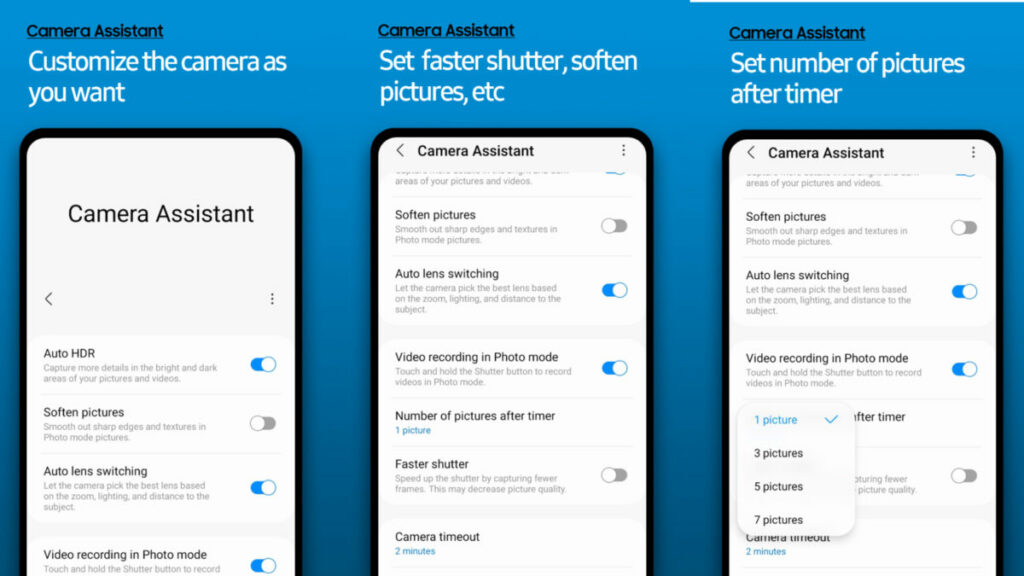

Samsung Engineering has signed a KRW793.8B (USD622.1M) contract with Samsung Electronics for a semiconductor plant construction project at the chipmaker’s manufacturing complex in Pyeongtaek, Gyeonggi. The engineering company will build a substation and other facilities at Pyeongtaek Line 4, a new factory also known as P4, at the Pyeongtaek complex. The size of the deal equals 10.6% of Samsung Engineering’s sales in 2021. The chipmaker is building 6 semiconductor factories at a site measuring 2.89M square meters (713 acres) in Pyeongtaek through 2030. Foundation work on the P4 factory began this year, and completion is scheduled for 2024. The P3 factory, the third manufacturing facility in the complex, began operation in September. Including P4, 3 more production facilities are set to be built by 2030. (Laoyaoba, TechNews, Korea JoongAng Daily)
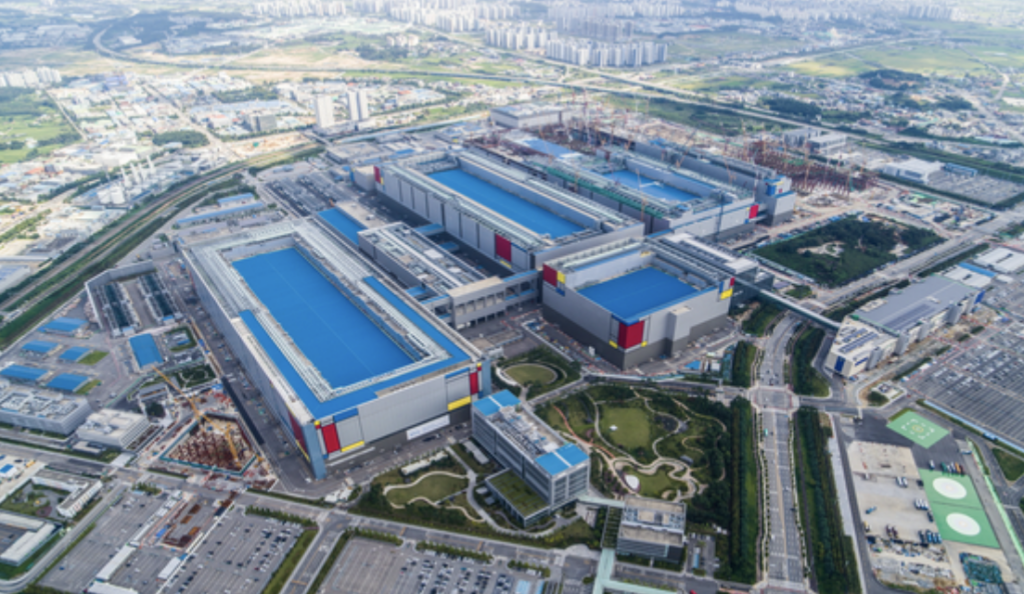
Client SSDs constituted a major driver of demand bit growth in the NAND Flash market for the past two years as the effects of the COVID-19 pandemic were spurring procurement activities related to working and studying from home. TrendForce currently projects that the attach rate of client SSDs among notebook computers will reach 92% in 2022 and around 96% in 2023. However, the demand surge related to the pandemic is subsiding, and the recent headwinds in the global economy have caused a demand freeze in the wider consumer electronics market. Hence, among the major application segments of the NAND Flash market, client SSDs are going to experience the most significant demand slowdown. This, in turn, will constrain demand bit growth as well. TrendForce projects that for the period from 2022 to 2025, the YoY growth rate of NAND Flash demand bits will remain below 30%. (Laoyaoba, TrendForce, TrendForce)

The Indian government is reportedly planning to introduce a common charging solution for wearable devices. It means that the Indian government could make it mandatory for all the upcoming wearables (such as smartwatches and wireless earbuds) in the country to have the same charging solution. At the moment, most brands, including Apple and Samsung, offer proprietary wireless charging solutions for their smartwatches. If the Indian government passes the law for a common charging solution for wearables, these brands will have to move away from their proprietary charging solutions and offer the one introduced by the Indian government. (Android Central, PTI, SamMobile)
SK On is planning to develop an electric vehicle (EV) battery that does not use cobalt. Cobalt is considered a conflict mineral and is more expensive than other materials used in batteries such as nickel and manganese. SK On is aiming to develop the battery within three years and is in talks with its cathode supplier to set a roadmap for the plan. The battery is highly likely to use lithium manganese iron phosphate, or LMFP, cathode. SK On is also currently developing lithium iron phosphate (LFP) batteries, both of which will likely be supplied to low- to mid-tier EVs.(The Elec, Techgoing)
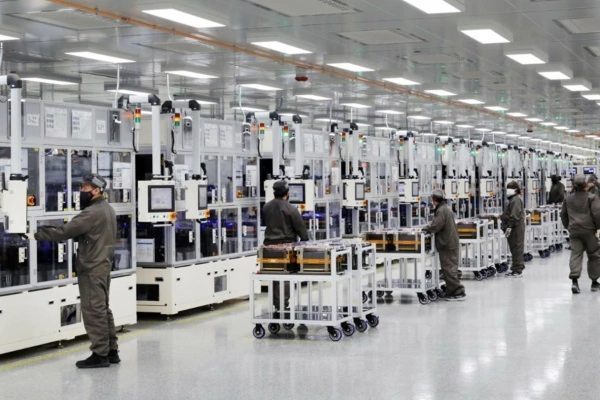
Sunwoda has revealed that the company’s ultra-fast charging battery has achieved small batch production in 2022, and the production capacity and delivery time of different versions will be planned, constructed and implemented in accordance with the actual needs of customers. It has also stated that the company’s current advanced solid-state battery technologies include: sulfide all-solid-state batteries with high-nickel positive electrodes and silicon-based negative electrodes/lithium metal negative electrodes, and new lithium-sulfur solid-state batteries. The company’s sodium-ion battery samples have been tested and verified, and the project is progressing smoothly. The specific listing plan will be determined according to customer needs. In terms of market development and services, Sunwoda has successively obtained designation letters from Dongfeng Liuqi, Dongfeng, Geely, SAIC, SAIC MAXUS, SAIC-GM-Wuling, GAC, etc., and cooperated with Renault, Nissan, EasyJet and other well-known automobile manufacturers at home and abroad have established cooperative relations.(Laoyaoba, Jiemian, 163)
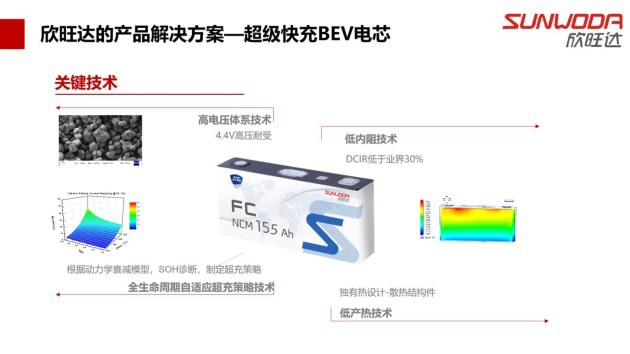

According to Strategy Analytics, as we approach the end of 2022, it is safe to say that 5G has been a major contributor to improved operator performance in 2022. 5G users increased from 819M in Jun 2022 to 924M in Sept and will have passed 1B in the last 4-5 weeks. Momentum continues to build for 5G globally. 5G networks will cover 36% of the world’s population by the end of Dec 2022 and 5G phones are closing in on accounting for half of all phones sold. (Stratetgy Analytics, IT Home, GizChina)
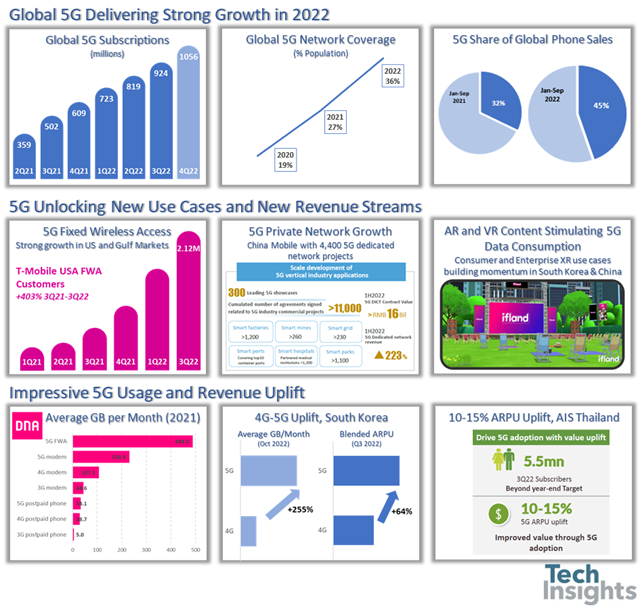

Xiaomi Group has has officially promoted Lu Weibing as the new President of its international business department of the group. Lu Weibing has been promoted to President of the international business department of the group and will even be managing the smartphone department, ecological chain department, major appliance department, China region, and India region of the group. (Gizmo China, My Drivers, IT Home)
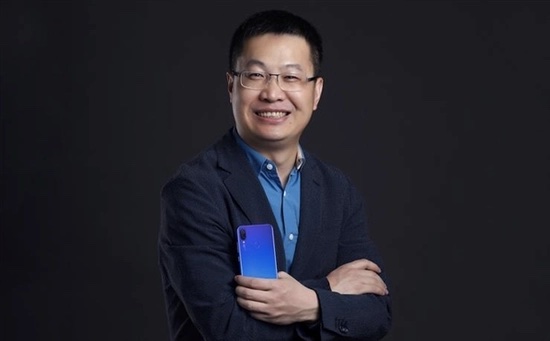
According to Counterpoint Research, Cumulative 5G smartphone shipments will cross the 100M mark in 2Q23 and exceed 4G smartphone shipments by the end of 2023. India’s 5G smartphone shipments are estimated to grow 81% YoY in 2022 driven by their expanding presence in lower price bands (<INR20,000 or ~USD244) and rollout of 5G networks. 5G share in lower price bands (<INR20,000 or ~USD244) is gradually increasing, from 4% in 2021 to 14% in 2022. (Gizmo China, Counterpoint Research)
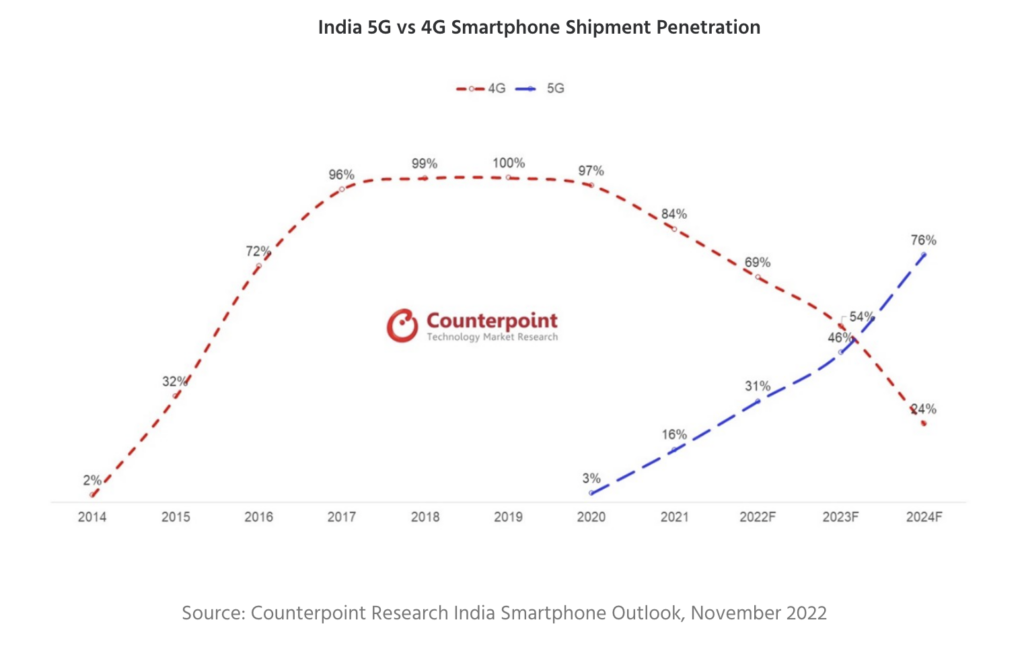
Wiko 5G is launched in China, which is a rebranded Huawei nova 9 SE with 5G functionality but the aesthetics are refreshed with some new changes. It is powered by Qualcomm Snapdragon 695 5G. The phone features Huawei’s operating system, HarnonyOS. The phone costs CNY1,999 (USD287) with 8+128GB memory configuration, or CNY2,199 (USD315) with 8+256GB. (Phone Arena, GSM Arena, Huawei Central)
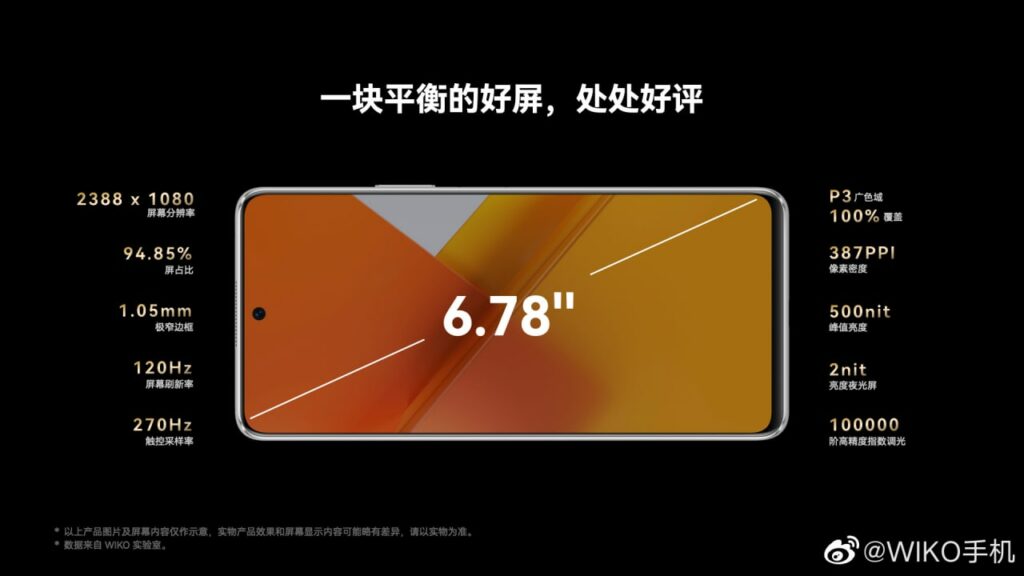
More and more smartphone OEMs are adopting the circular approach. Apple and Samsung stand out as leaders in sustainable initiatives. Each of the top OEMs performs differently across the three major stages of the smartphone circular economy – production, usage and end of life. OEM tie-ups with local sustainability partners have increased, leading to circular initiatives across geographies. But OEM initiatives fall short when compared to the volumes of new smartphones being shipped every year. Apple leads the smartphone space in the overall approach towards sustainability, according to Counterpoint Research. (Apple Insider, Counterpoint Research)
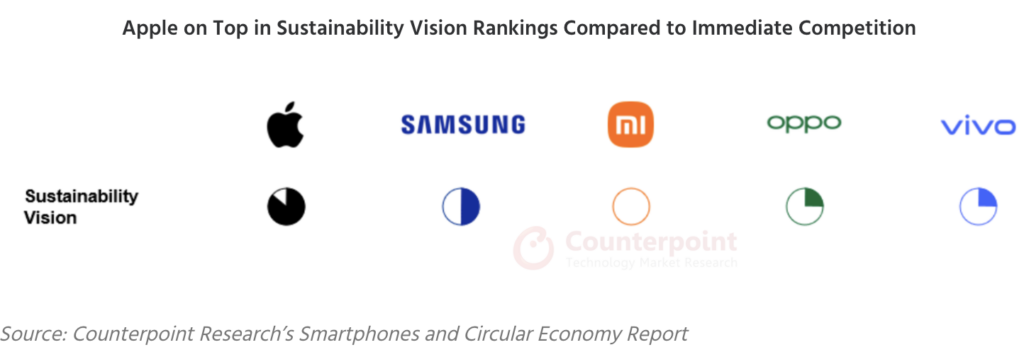
Huawei Technologies estimates its 2022 revenue remained flat, suggesting that its sales decline due to U.S. sanctions had come to a halt. Despite sales increasing a mere 0.02%, according to the rotating chairman Eric Xu, he has struck an upbeat tone. “U.S. restrictions are now our new normal, and we are back to business as usual”, according to Xu. That represents a tiny increase from 2021, when revenue hit CNY636.8B, and marked a 30% YoY sales tumble as the U.S. sanctions on the company took effect.(GizChina, Phone Arena, Reuters, Sohu)
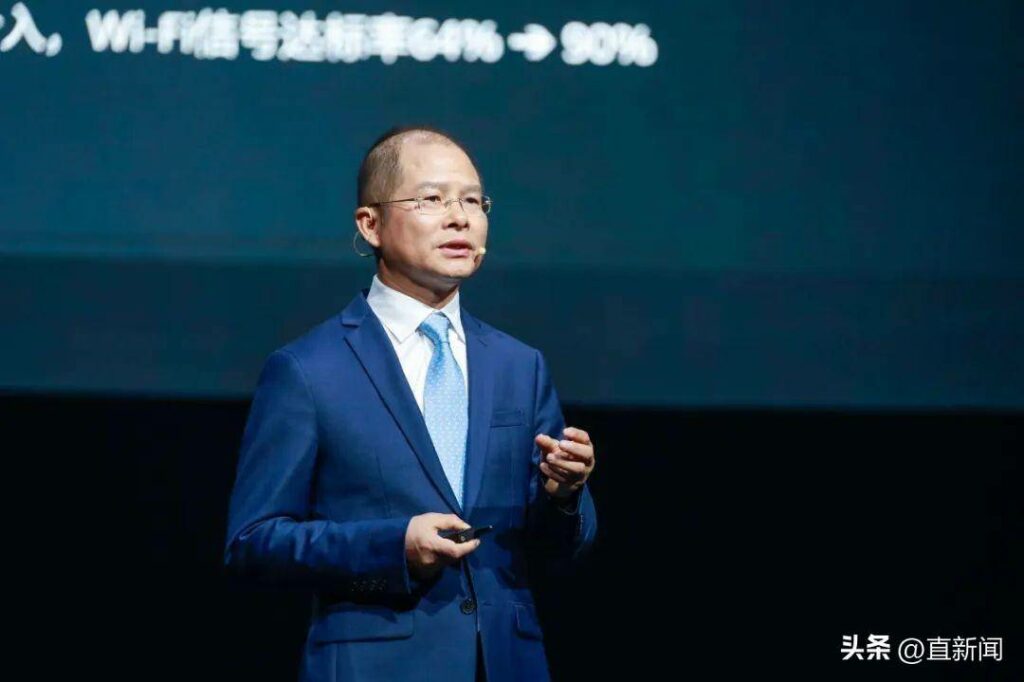

Starting in 2023, Fitbit will require a Google Account to use new devices and features. As part of transitioning to a single account system, Fitbit.com is losing support for Google sign-in. The Fitbit website’s sign-in page has been updated with the following message: “We are removing the option to log in to your account on fitbit.com with your Google credentials to support an improved experience coming soon”. (Android Central, 9to5Google)


Meta is purchasing Luxexcel, a smart eyewear company headquartered in the Netherlands. Founded in 2009, Luxexcel uses 3D printing to make prescription lenses for glasses. More recently, the company has focused its efforts on smart lenses, which can be printed with integrated technology like LCD displays and holographic film. It is rumored that Meta and Luxexcel had already worked together on Project Aria, the company’s augmented reality (AR) research initiative. (TechCrunch, The Verge, Tijd.be)
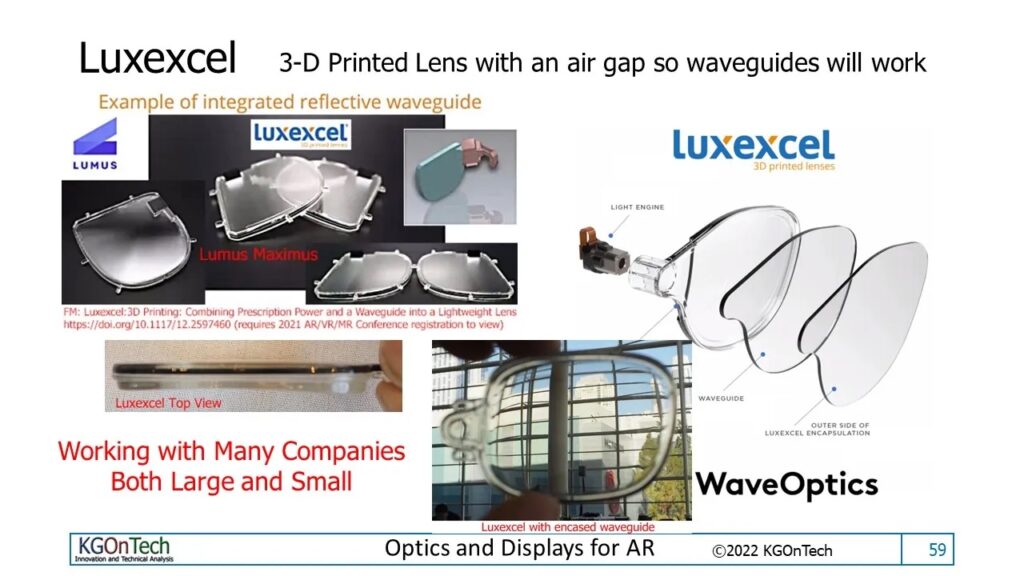

Amazon has begun delivering orders by drone. Amazon Prime Air is now operating in Lockeford, Calif. and College Station, Texas, delivering a small number of packages just in time for Christmas. Amazon officially received a green signal from the U.S. Federal Aviation Administration (FAA) in 2020 to start its drone delivery trials and was granted the “air carrier” status by authorities too. In Aug 2022, Amazon received approval from the FAA to use drones for package deliveries. The maximum payload for Prime Air is 5 lb, and Amazon says that 85% of its shipments fall under that weight. (Neowin, Ars Technica)
